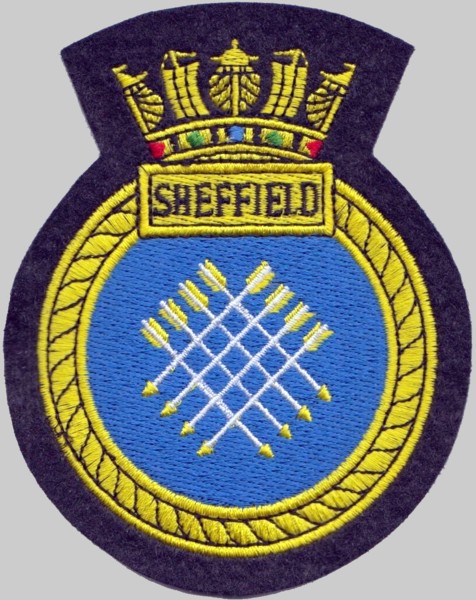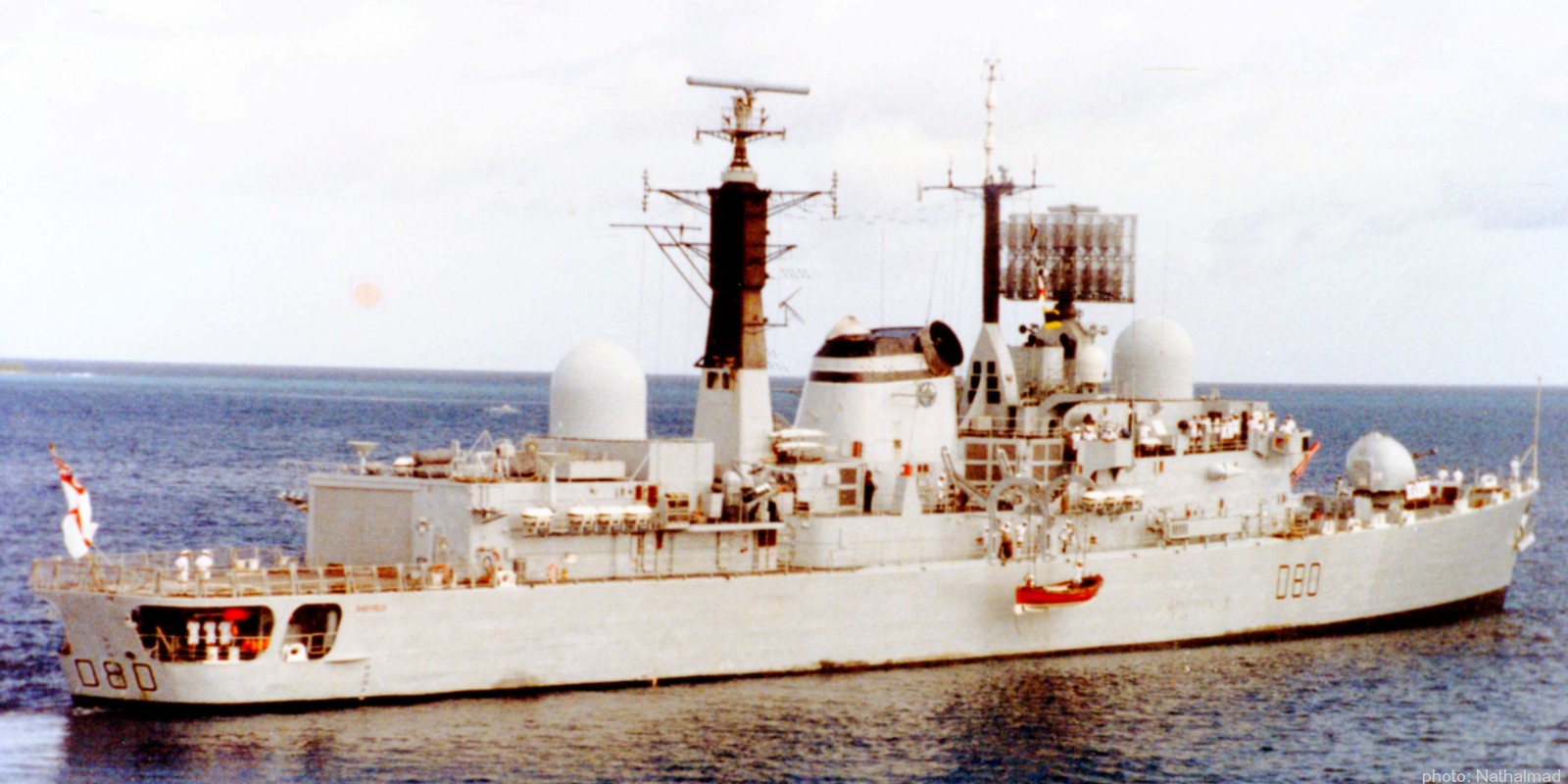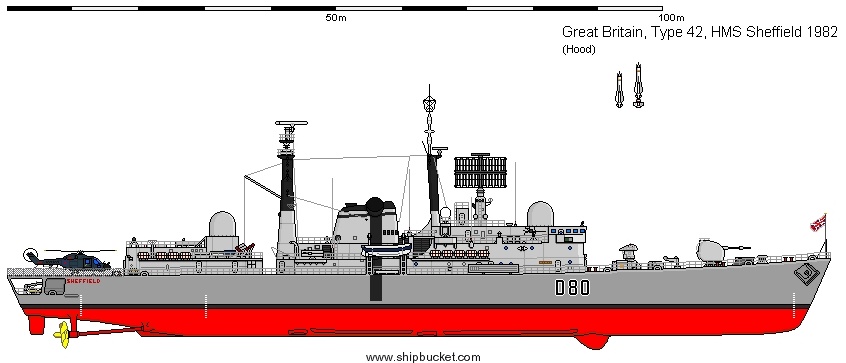|
|
|
|
HOME
|
US Navy -
ships
|
US Navy - air
units
|
USMC - air
units
|
International
Navies
|
Weapon Systems
|
Special Reports |
|
|
|
|
|
|
|
Royal Navy - Guided Missile DestroyerD 80 HMS Sheffield |
|
|
|
|
 |
 |
|
|
|
|
Type,
class: Guided Missile Destroyer; Sheffield / Type 42
class (Batch 1) Builder: Vickers Shipbuilding & Engineering, Barrow-in-Furness, Cumbria, U.K. STATUS: Awarded: Laid down: January 15, 1970 Launched: June 10, 1971 Commissioned: February 16, 1975 Decommissioned: Fate: sunk on May 10, 1982 after Argentine air attack during the Falklands War Homeport: - Namesake: City of Sheffield, Yorkshire Ships Motto: DEO ADJUVANTE LABOR PROFICIT (with god's help our labour is successful) Technical Data: see INFO > Sheffield / Type 42 class Guided Missile Destroyer |
|
|
|
|
ship images |
|
  |
|
|
|
|
|
HMS Sheffield (D 80): HMS Sheffield was the second Royal Navy ship to be named after the city of Sheffield in Yorkshire. She was a Type 42 Guided Missile Destroyer laid down by Vickers Shipbuilding and Engineering at Barrow-in-Furness on 15 January 1970. She was launched by Queen Elizabeth II on 10 June 1971 and commissioned on 16 February 1975. An explosion during construction killed two dockyard workers and damaged a section of hull which was replaced with a section from an identical ship, Hércules, being built for the Argentine Navy. The ship was part of the task force sent to the Falkland Islands during the Falklands War. She was struck by an Exocet air-launched anti-ship missile from a Super Etendard aircraft belonging to the Argentine Navy on 4 May 1982 and foundered on 10 May 1982. Sinking: Sheffield was first detected by an Argentine Naval Aviation patrol aircraft Lockheed SP-2H Neptune (2-P-112) at 7:50 AM on 4 May 1982. The Neptune kept the British ships under surveillance, verifying Sheffield's position again at 8:14 and 8:43. Two Argentine Navy Super Etendards (3-A-202 and 3-A-203) both armed with Exocets took off from Rio Grande, Tierra del Fuego at 9:45 and met with an Argentine Air Force tanker KC-130H Hercules at 10:00 hours. At 10:35, the Neptune climbed to 1,170 metres (3,840 ft) and detected a large and two medium-sized contacts at the coordinates 52°33′55″S, 57°40′55″W. A few minutes later, the Neptune contacted both Super Étendards with this information. Flying at very low altitude, around 10:50, both Super Étendards climbed to 160 metres (520 ft) to verify these contacts, but, not finding any, decided to continue. 25 miles (40 km) later they climbed again and, after a few seconds of scanning, the targets appeared on their radar screens. Both pilots loaded the coordinates in their weapons systems, returned to low level, and after last minute checks, launched their AM39 Exocets at 11:04 from 20 to 30 miles (32 to 48 km) away from their targets. The Super Étendards did not need to refuel from the KC-130 again, which had been waiting, and landed at Rio Grande at 12:04. Supporting the mission were an Argentine Air Force Learjet 35 as a decoy and two IAI Daggers as the KC-130 escorts. At approximately 10 a.m. on 4 May, Sheffield was at defence watches, second degree readiness, as part of the British Task Force dispatched to the Falkland Islands during the Falklands War. Sheffield had relieved her sister Coventry as the latter was having technical trouble with her Type 965 radar. Sheffield and Coventry were chatting over UHF. Communications ceased until an unidentified message was heard flatly stating "Sheffield is hit". The flagship, Hermes dispatched the escorts Arrow and Yarmouth to investigate, and a helicopter was launched. Confusion reigned until Sheffield's Lynx helicopter unexpectedly landed aboard Hermes carrying the air operations officer and operations officer, confirming the strike. Sheffield picked up the incoming missiles on her Type 965 radar (an interim fitting until the Type 1022 set was available), and the operations officer informed the missile director, who queried the contacts in the ADAWS 4 fire control system. The launch aircraft had not been detected as the British had expected, and it was not until smoke was sighted that the target was confirmed as sea skimming missiles. Five seconds later, an Exocet hit Sheffield amidships, approximately 8 feet (2.4 m) above the waterline on deck 2, tearing a gash in the hull. The other missile splashed into the sea half a mile off her port beam. Damage caused by the missile impact severed the high-pressure fire main on board. The resultant fire caused by burning propellant ignited diesel oil from the ready-use tanks in the engine room, and other inflammable materials used in the ship's construction. These fires burned unchecked for a number of days after the ship was abandoned. The Exocets were fired from two Super Étendards launched from Río Grande, Tierra del Fuego, Naval Air Base. The aircraft were piloted by Teniente (Lieutenant) Armando Mayora and Capitán de Fragata (Lt Commander) Augusto Bedacarratz, who commanded the mission. Such was the lack of warning, there was no time to engage in defensive manoeuvres, leading to a change in British policy whereby any Royal Navy vessel that suspected it might be under missile attack would turn toward the threat, accelerate to maximum speed and fire chaff to prevent a ship being caught defenceless again. The codeword used to start this procedure was "handbrake", which had to be broadcast once the signal of the Agave radar of the Super Étendard was picked up. The MOD Board of Inquiry on the sinking of the Sheffield concluded that: "Evidence indicates that the warhead did not detonate". Some of the crew and members of the Task Force believe that the missile's 165 kilogram warhead had detonated, upon impact. This was supported by a MOD re-assessment of the loss of the 'Sheffield' which reported in Summer 2015. In a paper delivered to the RINA Warship Conference in Bath in June 2015 it was concluded that the Exocet warhead did detonate inside 'Sheffield', with the conclusion supported by analysis using modern damage analysis tools not available in 1982 and evidence from weapon hits and trials conducted since the end of the Falklands Campaign. Irrespective of this, the impact of the missile and the burning rocket motor set Sheffield ablaze. Some accounts suggest that the initial impact of the missile immediately crippled the ship's onboard electricity generating systems, but this only affected certain parts of the ship, which caused ventilation problems. The missile strike fractured the water main, preventing the anti-fire mechanisms from operating effectively, and thereby dooming the ship to be consumed by the raging fire. After the ship was struck and as her crew were waiting to be rescued, Sub Lieutenant Carrington-Wood led the crew in singing "Always Look on the Bright Side of Life" from Monty Python’s Life of Brian. Over the six days from 4 May 1982, five inspections were made to see if any equipment was worth salvaging. Orders were issued to shore up the hole in Sheffield's starboard side and tow the ship to South Georgia. However, before these orders were effected the burnt-out hulk had already been taken in tow by the Rothesay-class frigate Yarmouth. The high seas that the ship was towed through caused slow flooding through the hole in the ship's side. This was the cause which eventually took her to the bottom. The ship sank at 53°04′S, 56°56′W on 10 May 1982, the first Royal Navy vessel sunk in action since World War II. Twenty of her crew (mainly on duty in the galley area and in the computer room) died as a result of the attack. The wreck is a war grave and designated as a protected place under the Protection of Military Remains Act 1986. The sinking of Sheffield is sometimes blamed on a superstructure made wholly or partially from aluminium, the melting point and ignition temperature of which are significantly lower than those of steel. However, this is incorrect as Sheffield's superstructure was made entirely of steel. The confusion is related to the US and British Navies abandoning aluminium after several fires in the 1970s involving ships that had aluminium superstructures. The sinking of the Type 21 frigates Antelope and Ardent, both of which had aluminium superstructures, probably also had an effect on this belief though these cases are again incorrect and the presence of aluminium had nothing to do with their loss. source: wikipedia (2016) |
|
|
|
|
|
|
|
|
patches |
|
|
|
|
|
|
seaforces.org
|
Royal
Navy start page
| |
|
